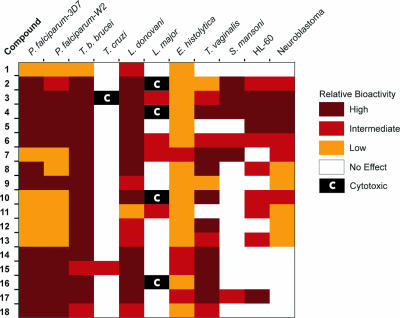FIG. 1.
Relative antiparasitic bioactivities and mammalian cell cytotoxicities of bis-acridine compounds. Compounds were assayed for bioactivity against the parasite indicated and scored as follows. For P. falciparum 3D7 and W2, EC50 values were categorized as high (<150 nM), intermediate (150 to 300 nM), or low (>300 nM). For T. b. brucei bloodstream forms, EC50 values were categorized as high (<10 nM), intermediate (10 to 100 nM), or low (>100 nM). For T. cruzi amastigotes, the compound at 5 μM was categorized as either having no effect or being cytotoxic to macrophages. At 10 μM, only compound 15 was trypanostatic and is indicated as “intermediate.” For L. donovani promastigotes, percentages of parasite deaths at a compound concentration of 10 μM were categorized as high (>66%), intermediate (33 to 66%), or low (<33%). For L. major amastigotes, all compounds (except 5 and 7) were toxic to macrophages at 10 μM; otherwise, EC50 values were categorized as high (<1.0 μM), intermediate (1 to 10 μM), or no effect (>10 μM). Compounds cytotoxic to macrophages at 1 μM are indicated. For E. histolytica, EC50 values were categorized as intermediate (0.5 to 1.0 μM) or low (5.0 to 10 μM). For T. vaginalis; percentages of parasite deaths at a compound concentration of 10 μM were categorized as high (>66%), intermediate (33 to 66%), low (<33%), or no effect (0). For S. mansoni 20-day-old worms, the effects of a compound concentration of 3 μM were categorized as high (dead), intermediate (dying), or no effect (viable). For HL-60 cells, EC50 values were categorized as high (100 to 200 nM), intermediate (200 to 500 nM), low (500 to 1,000 nM), or no effect (>1,000 nM). For neuroblastoma N2a cells, percent cytotoxicity of each compound at 200 nM relative to untreated control cells (26) was categorized as high (>66%), intermediate (33 to 66%), or low (<33%). The figure was prepared using the software JColorGrid (22).

